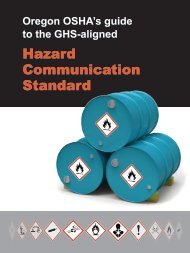Technical Manual - Section 3 (Safety Hazards)
Technical Manual - Section 3 (Safety Hazards)
Technical Manual - Section 3 (Safety Hazards)
You also want an ePaper? Increase the reach of your titles
YUMPU automatically turns print PDFs into web optimized ePapers that Google loves.
Table III:2-14 HYDRODESULFURIZATION PROCESS<br />
Feedstocks From Process Typical products......................To<br />
Naphthas, distillates Atmospheric & Treating, Naphtha....................................Catalytic reformer<br />
Sour gas oil, vacuum tower hydrogenation Hydrogen..................................Recycle<br />
Residuals Catalytic & Distillates..................................Blending<br />
thermal cracker<br />
H 2 S, ammonia...........................Sulfur plant, treater<br />
Gas.............................................Gas plant<br />
<strong>Safety</strong><br />
Many processes require hydrogen generation to provide for<br />
a continuous supply. Because of the operating temperatures<br />
and presence of hydrogen, the hydrogen sulfide content of the<br />
feedstock must be strictly controlled to a minimum to reduce<br />
corrosion. Hydrogen chloride may form and condense as<br />
hydrochloric acid in the lower-temperature parts of the unit.<br />
Ammonium hydrosulfide may form in high-temperature,<br />
high-pressure units. Excessive contact time and/or<br />
temperature will create coking. Precautions need to be taken<br />
when unloading coked catalyst from the unit to prevent iron<br />
sulfide fires. The coked catalyst should be cooled to below<br />
120 o F before removal,<br />
or dumped into nitrogen-inerted bins where it can be cooled<br />
before further handling. Special antifoam additives may be<br />
used to prevent catalyst poisoning from silicone carryover in<br />
the coker feedstock.<br />
Health<br />
Because this is a closed process, exposures are expected to be<br />
minimal under normal operating conditions. There is a<br />
potential for exposure to hydrogen sulfide or hydrogen gas in<br />
the event of a release, or to ammonia should a sour-water leak<br />
or spill occur. Phenol also may be present if high<br />
boiling-point feedstocks are processed. Safe work practices<br />
and/or appropriate personal protective equipment may be<br />
needed for exposures to<br />
Figure III:2-17 Distillate Hydrodesulffurization<br />
III:2-34
















